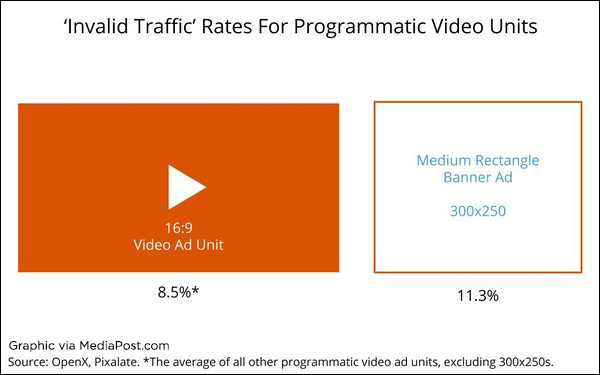
March 8, 2018 — By: Joe Mandese, MediaPost
"The blocky 300x250 banner ad has long been one of the most common ad units in the display advertising marketplace, but thanks to some ingenuity, cunning and outright fraud, it has also become one of the most common video advertising units sold via programmatic ad exchanges," wrote MediaPost.
"According to a first-of-its-kind analysis, the postage stamp-like 300x250 banner ad now represents nearly a third of all video ad units sold programmatically," the article reads, citing research done by Pixalate in conjunction with OpenX.

"According to the Pixalate analysis, about 11.3% of 300x250 programmatic video ads meet the industry’s standard for 'invalid traffic,' whereas only 8.5% of all other programmatic video ad units (excluding 300x250s) are deemed invalid," wrote MediaPost.
"We were surprised by how pervasive this ad unit was,” said John Murphy, vice president of marketplace quality at programmatic ad exchange OpenX, according to MediaPost. He added: "There are cases where some publishers are legitimately offering 300x250 video units, but we believe they often misrepresent the nature of the ad unit, claiming it is a standard ad size, in which case it is fraud.
MediaPost wrote: "The problem began when enterprising programmatic arbitrageurs figured out they could buy low-demand 300x250 banner units and stuff them with much higher-demand -- and more expensive -- video ad players."

The article notes that, as part of the release of this data, OpenX has announced "that it will no longer trade 300x250 video ad units on its exchange."
“Video ad quality is paramount in today’s programmatic marketplace,” said Jalal Nasir, CEO of Pixalate, in a press release announcing the findings. “We applaud OpenX for taking a stand, backed by data-driven analysis, to improve the overall quality of the programmatic video ecosystem. We encourage others to take similar steps in a bid to improve quality across the board.”
According to OpenX's independent research, the 300x250 video "ad size is 80 percent less viewable compared to all other video ad sizes and they are 98 percent less likely to be completed while visible and audible."
Sign up for our blog to stay updated with new stats, trends, and analysis on digital ad fraud.
*By entering your email address and clicking Subscribe, you are agreeing to our Terms of Use and Privacy Policy.
These Stories on Thought Leadership
*By entering your email address and clicking Subscribe, you are agreeing to our Terms of Use and Privacy Policy.

Disclaimer: The content of this page reflects Pixalate’s opinions with respect to the factors that Pixalate believes can be useful to the digital media industry. Any proprietary data shared is grounded in Pixalate’s proprietary technology and analytics, which Pixalate is continuously evaluating and updating. Any references to outside sources should not be construed as endorsements. Pixalate’s opinions are just that - opinion, not facts or guarantees.
Per the MRC, “'Fraud' is not intended to represent fraud as defined in various laws, statutes and ordinances or as conventionally used in U.S. Court or other legal proceedings, but rather a custom definition strictly for advertising measurement purposes. Also per the MRC, “‘Invalid Traffic’ is defined generally as traffic that does not meet certain ad serving quality or completeness criteria, or otherwise does not represent legitimate ad traffic that should be included in measurement counts. Among the reasons why ad traffic may be deemed invalid is it is a result of non-human traffic (spiders, bots, etc.), or activity designed to produce fraudulent traffic.”

